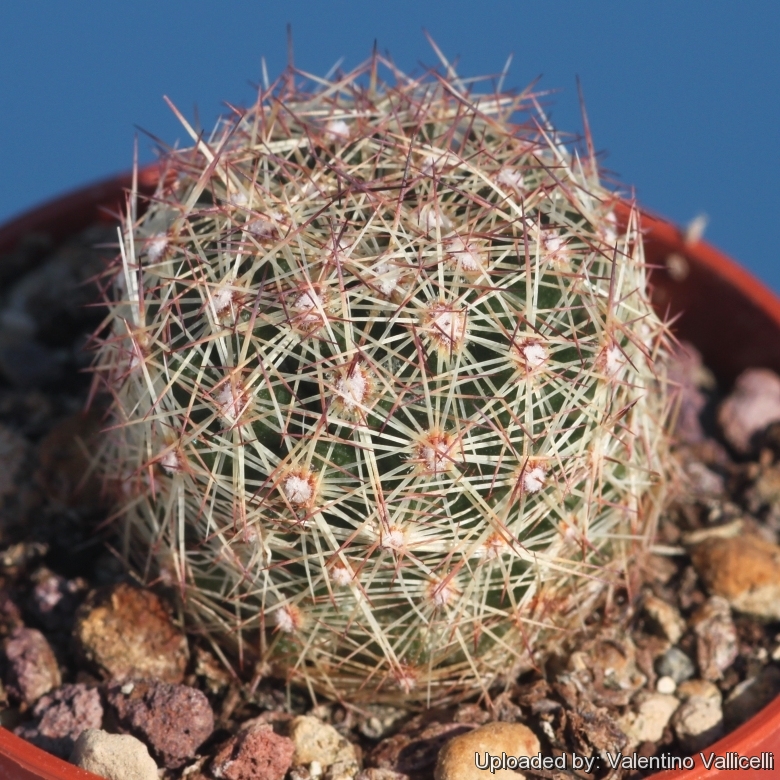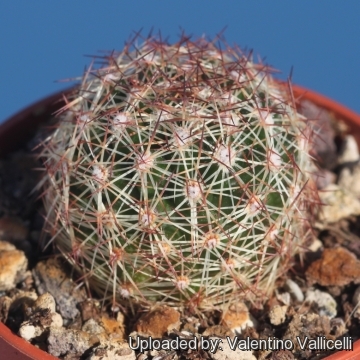Accepted Scientific Name: Escobaria chihuahuensis Britton & Rose
Cactaceae (Britton & Rose) 4: 55. 1923 [24 Dec 1923] Britton & Rose

Coryphantha chihuahuensis (Escobaria chihuahuensis) Photo by: Valentino Vallicelli
Origin and Habitat: North Mexixo, chihuahua
Habitat: Common in the mountains near Chihuahua.
Synonyms:
See all synonyms of Escobaria chihuahuensis
Common Names include:
ENGLISH: Cob Cory-cactus
Description: Usually simple or caespitose and very spiny, usually hidden by the spines.
Root: Tuberous roots.
Stems: Spherical to short cylindric up to 20 cm tall and 7 cm in diameter, very variable ill size and shape.
Tubercles: Short grooved on their adaxial (upper) sides in sexually mature plants.
Radial spines: Numerous, dull white, spreading, mostly somewhat adpressed on the stem.
Central spines: several, longer than radials, usually brown or black in upper part
Flowers: Small, produced laterally (like in mammillarias) and not apically, 1-2 cm long and up to 2 cm in diameter, pale pink to purplish. Outer perianth-segments broad, often rounded at apex with ciliate margins; inner perianth-segments pointed. Stigma-lobes, 5-6 white.
Blooming season: Spring.
Fruit: Up to 10 mm long and 7 mm broad, green, oblong.
Note: Coryphantha chihuahuensis and Coryphantha henricksoniiSN|10220]]SN|10220]] are treated by Zimmerman as intermediate between Escobaria and Coryphantha
Subspecies, varieties, forms and cultivars of plants belonging to the Escobaria chihuahuensis group
Bibliography: Major references and further lectures
1) David Hunt, Nigel Taylor “The New Cactus Lexicon” DH Books, 2006 ISBN 0953813444, 9780953813445
2) Kakeen und andere Sukkulenten 34: 77. 120 (1983)
3) Nathaniel Lord Britton, Joseph Nelson Rose “Cactaceae: Descriptions and Illustrations of Plants of the Cactus Family” Courier Dover Publications, 1963
4) Reto F. Dicht, Adrian D. Lüthy “Coryphantha: Cacti of Mexico and Southern USA” Springer, 01/Jan/2005
5) Edward F. Anderson “The Cactus Family” Timber Press, 2001
 Coryphantha chihuahuensis (Escobaria chihuahuensis) Photo by: Valentino Vallicelli
Coryphantha chihuahuensis (Escobaria chihuahuensis) Photo by: Valentino VallicelliSend a photo of this plant.The gallery now contains thousands of pictures, however it is possible to do even more. We are, of course, seeking photos of species not yet shown in the gallery but not only that, we are also looking for better pictures than those already present.
Read More... Cultivation and Propagation: Escobaria chihuahuensisSN|10117]]SN|10117]] is an easy to grow succulent, more cold tolerant than most and less fussy regarding soil conditions.
Growth rate: It is a relatively rapidly growing and easily flowering species that will make clumps given the best conditions.
Soils: It likes very porous standard cactus mix soil.
Repotting: Use pot with good drainage.
Watering: Water regularly in summer, but do not overwater (Rot prone), keep dry in winter.
Fertilization: Feed with a high potassium fertilizer in summer.
Hardiness: Reputedly somewhat resistant to frost if kept on the dry side prior to, and during, cold weather (hardy to -12C ° C for short periods).
Exposition: Outside bright but sunlight or afternoon shade, inside it needs bright light, and some direct sun. Tends to bronze in strong light, which encourages flowering and heavy spine production.
Uses: It is an excellent plant for container growing. It always looks good and stays small. It look fine in a cold greenhouse and frame or outdoor in a rockery.
Pests & diseases: It may be attractive to a variety of insects, but plants in good condition should be nearly pest-free, particularly if they are grown in a mineral potting-mix, with good exposure and ventilation. Nonetheless, there are several pests to watch for:
- Red spiders: they may be effectively rubbed up by misting the vulnerable plants every day
- Mealy bugs: occasionally they develop aerial into the new growth among the wool with disfiguring results, but the worst types develop underground on the roots and are invisible except by their effects.
- Sciara Flies: they are one of the major problems for seedlings. It is a good practice to mulch your seedlings with a layer of grit, which will strongly discourage the flies.
- Scales: they are rarely a problem.
It is wise to treat your whole collection with a systemic insecticide twice a year in spring and autumn.
- Rot: it is only a minor problem with cacti if the plants are watered and “aired” correctly. If they are not, fungicides won't help all that much.
Propagation: Division, direct sow after last frost. Seeds germinate in 7-14 days at 21-27° C in spring, remove gradually the glass cover as soon the plants will be well rooted (ca 3 days) and keep ventilated, no full sun for young plants! To make a cutting twist off a branch and permit it to dry out a couple of weeks, lay it on the soil and insert the stem end partially into the soil. Try to keep the cutting somewhat upright so that the roots are able to grow downward.











